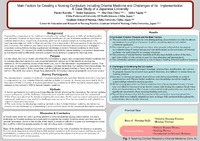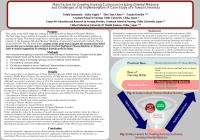| dc.description.abstract | <p>Session presented on Monday, November 9, 2015 and Tuesday, November 10, 2015:</p>
<p><strong>Background:</strong> Prompted by a suggestion in the model core curriculum for medical education in 2001, all medical faculties and university hospitals in Japan have successively established courses in Oriental medicine and Oriental medicine departments, respectively. Conversely, there are no requisite courses at nursing universities teaching knowledge and skills in Oriental medicine; this subject holds a different position in the curriculum at each university. This indicates that nurses working in Oriental medicine departments have to engage in outpatient nursing without having acquired any knowledge or skills in Oriental medicine in their basic education courses. It's necessary to clarify knowledge and skills for nurses working at outpatient department in this field in order to effectively attend to patients and to develop a program for teaching them.</p>
<p><strong>Research</strong> Aims: For this study, the author visited one of the few universities in Japan that incorporates Oriental medicine into its nursing education curriculum and conducted interview surveys on (a) the details of creating the curriculum, (b) the practical content of the curriculum, and (c) the educational implementation system. This study aims to examine the main factors for creating a nursing curriculum that includes Oriental medicine, the current teaching content of the curriculum, and the challenges in implementing it, based on the interview surveys. The study also aims to obtain basic material for developing training programs for outpatient nurses.</p>
<p><strong>Survey Participants:</strong> Two nursing faculty members (1 professor, 1 associate professor) who have been directly involved in creating a nursing curriculum that includes Oriental medicine at Public University A. Overview of Public University A: A prefectural university, established in 2003, located in western Japan. The curriculum was revised in 2008 to include Oriental medicine. Research Methods 1) Survey participants were interviewed regarding the details of creating the curriculum, the current teaching content and system, and the challenges. Interviews were recorded with permission and then transcribed. 2) The discussions about (a) the details of creating the curriculum, (b) the teaching content and system related to Oriental medicine/nursing, and (c) its challenges were extracted from the transcriptions and included into respective descriptive materials. 3) The main factors for developing a nursing curriculum that includes Oriental medicine, the curriculum content, and the challenges of implementing it were examined based on the formulated descriptive materials.</p>
<p><strong>Results</strong> 1. Curriculum Creation Process: At the time when University A revised its curriculum, new nursing universities in Japan were being created at a rate of 10-20 programs per year. Furthermore, this exactly coincided with a drop in the 18-year old population and a situation in which the number of university applicants was fewer than the fixed university entrance quota. Even though it was a popular public university, it had to differentiate itself from other universities and more prominently market itself in order to attract the top students. At this time, one of the interview participants was the undergraduate dean. In addition, University A also had two professors who believed that the Oriental medicine understanding of human beings and health care were essential to nursing practice, and moreover, it was necessary to have this at the core of nursing education. Furthermore, one of the nursing faculty members was a British priest who had a nursing license and had taken charge of a course titled Healing Theory after the university was established. Equipped with these human resources and with a conviction backed by personal medical treatment and nursing practice experience, the dean adopted an educational policy, unique to University A, of developing competence in practical care focused on a holistic understanding of human beings and natural healing power. The dean personally led the changes in the curriculum in line with these objectives. During that process, the university received cooperation from doctors at one of Japan's leading Oriental medicine hospitals, located near the university, as well as specialist nurses in Chinese medicine from a state university in China with which the university had formed a sister-school relationship several years before. With core efforts from the faculty members mentioned above, it was possible to incorporate several courses related to Oriental medicine into the curriculum. The following three points were the main factors enabling the creation of a nursing curriculum that includes Oriental medicine: 1) The university's need to form its own distinguishing characteristics in order to attract top students in a social environment in which university seats outnumbered university applicants. 2) The leadership of the undergraduate dean, who strongly believed that developing an understanding of human beings and care skills based on the principles of Oriental medicine was indispensable to nursing education. 3) The presence of several faculty members with the same beliefs as that of the dean, and their ability to take action on specific class planning and management. 4) The university's physical proximity to one of Japan's leading Oriental medicine hospitals. 2. Overview of Teaching Content Related to Oriental Medicine at University A. University A currently has the following courses related to Oriental medicine. 1) Holistic Human Theory (1 st year course, required) 1 credit 2) Healing Theory (1 st year course, required) 1 credit 3) Introduction to Oriental Medicine (2 nd year course, required) 1 credit 4) Healing Therapy (2 nd year course, elective) 1 credit 5) Oriental Nursing Practice (3 rd year intensive course, elective) 1 credit From the interviews with the faculty members in relation to 3) and 5) above, the author derived the following as challenges in continuing the curriculum. 1) Oriental medicine care techniques (massage, acupuncture, moxibustion, etc.) cannot be properly learned in a limited time period; therefore, it is difficult to utilize these in nursing practice. 2) Lectures by doctors are mainly derived from each doctor's knowledge of medical examinations and Chinese herbal medicine; such knowledge cannot be taught as a methodology related to nursing practice. 3) While inviting specialists in Chinese medicine from China requires finance, it is not very cost-effective because it is an elective course held during the summer break when there are fewer students. The finance is obtained through prefectural tax, and there is significant uncertainty about securing funding each year. 4) Two of the professors that led the creation of the curriculum have retired and the policies that were initially adopted are now no longer fully permeated throughout the entire faculty due to faculty turnover.</p>
<p><strong>Discussion:</strong> In recent years, there has been a growing interest in Oriental medicine among clinical nurses, and many workshops on Oriental medicine have been held throughout the country. However, these have been one-off, sporadic workshops. Based on the results of this study, it would be difficult to acquire any knowledge to a level that could be utilized in nursing practice by only attending such a workshop. Many of the challenges found in this study are attributable to the state of academic development in nursing. It is extremely important to identify how to link medical knowledge with nursing practice and how to construct methodologies to achieve this as well as to clarify and theorize the relationship between the principles of Oriental medicine and nursing practice.</p> | en |





